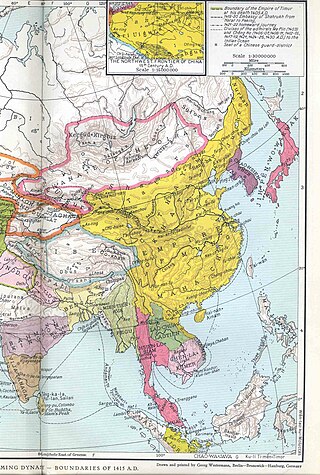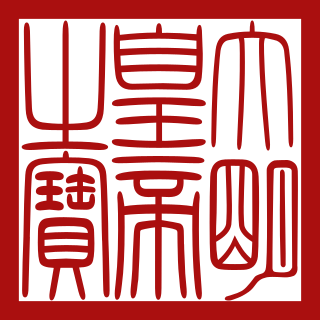Related Research Articles

Confucianism, also known as Ruism or Ru classicism, is a system of thought and behavior originating in ancient China, and is variously described as a tradition, philosophy, religion, theory of government, or way of life. Confucianism developed from teachings of the Chinese philosopher Confucius (551–479 BCE), during a time that was later referred to as the Hundred Schools of Thought era. Confucius considered himself a transmitter of cultural values inherited from the Xia (c. 2070–1600 BCE), Shang (c. 1600–1046 BCE) and Western Zhou dynasties (c. 1046–771
Chinese classic texts or canonical texts or simply dianji (典籍) refers to the Chinese texts which originated before the imperial unification by the Qin dynasty in 221 BC, particularly the "Four Books and Five Classics" of the Neo-Confucian tradition, themselves a customary abridgment of the "Thirteen Classics". All of these pre-Qin texts were written in either Old or Classical Chinese. All three canons are collectively known as the Classics.

The Ming dynasty, officially the Great Ming, was an imperial dynasty of China, ruling from 1368 to 1644 following the collapse of the Mongol-led Yuan dynasty. The Ming dynasty was the last imperial dynasty of China ruled by the Han people, the majority ethnic group in China. Although the primary capital of Beijing fell in 1644 to a rebellion led by Li Zicheng, numerous rump regimes ruled by remnants of the Ming imperial family—collectively called the Southern Ming—survived until 1662.

The Hongwu Emperor, also known by his temple name as the Emperor Taizu of Ming, personal name Zhu Yuanzhang, courtesy name Guorui, was the founding emperor of the Ming dynasty, reigning from 1368 to 1398.

Zhu Xi, formerly romanized Chu Hsi, was a Chinese calligrapher, historian, philosopher, poet, and politician during the Song dynasty. Zhu was influential in the development of Neo-Confucianism. He contributed greatly to Chinese philosophy and fundamentally reshaped the Chinese worldview. His works include his editing of and commentaries to the Four Books, his writings on the process of the "investigation of things", and his development of meditation as a method for self-cultivation.
The recorded military history of China extends from about 2200 BC to the present day. Chinese pioneered the use of crossbows, advanced metallurgical standardization for arms and armor, early gunpowder weapons, and other advanced weapons, but also adopted nomadic cavalry and Western military technology. China's armies also benefited from an advanced logistics system as well as a rich strategic tradition, beginning with Sun Tzu's The Art of War, that deeply influenced military thought.
The Censorate was a high-level supervisory agency in Imperial China, first established during the Qin dynasty.

Shen Zhou, courtesy names Qi'nan (启南) and Shitian (石田), was a Chinese painter in the Ming dynasty. He lived during the post-transition period of the Yuan conquest of the Ming. His family worked closely with the government and maintained its wealthy status. Shen later retired and lived a reclusive life, spending most of his time painting and taking care of his widowed mother.

The Guozijian, sometimes translated as the Imperial College, Imperial Academy, Imperial University, National Academy, or National University, was the national central institution of higher learning in Chinese dynasties after the Sui dynasty. It was the highest institution of academic research and learning in China's traditional educational system, with the function of administration of education.

The Duke Yansheng, literally "Honorable Overflowing with Wisdom", sometimes translated as Holy Duke of Yen, was a Chinese title of nobility. It was originally created as a marquis title in the Western Han dynasty for a direct descendant of Confucius.

The Yuan dynasty, officially the Great Yuan, was a Mongol-led imperial dynasty of China and a successor state to the Mongol Empire after its division. It was established by Kublai, the fifth khagan-emperor of the Mongol Empire from the Borjigin clan, and lasted from 1271 to 1368. In Chinese history, the Yuan dynasty followed the Song dynasty and preceded the Ming dynasty.

Mounted archery is a form of archery that involves shooting arrows while on horseback. A horse archer is a person who does mounted archery. Archery has occasionally been used from the backs of other riding animals. In large open areas, it was a highly successful technique for hunting, for protecting herds, and for war. It was a defining characteristic of the Eurasian nomads during antiquity and the medieval period, as well as the Iranian peoples such as the Alans, Sarmatians, Cimmerians, Scythians, Massagetae, Parthians, and Persians in Antiquity, and by the Hungarians, Mongols, Chinese, and Turkic peoples during the Middle Ages. The expansion of these cultures have had a great influence on other geographical regions including Eastern Europe, West Asia, and East Asia. In East Asia, horse archery came to be particularly honored in the samurai tradition of Japan, where horse archery is called Yabusame.
During the late Zhou dynasty, the inhabitants of the Central Plains began to make a distinction between Hua and Yi, referred to be some historians as the Sino–barbarian dichotomy. They defined themselves as part of cultural and political region known as Huaxia, which they contrasted with the surrounding regions home to outsiders, conventionally known as the Four Barbarians. Although Yi is usually translated as "barbarian", other translations of this term in English include "foreigners", "ordinary others", "wild tribes" and "uncivilized tribes". The Hua–Yi distinction asserted Chinese superiority, but implied that outsiders could become Hua by adopting their culture and customs. These concepts were not unique to Ancient China, but were also applied by the Vietnamese, Japanese, and Koreans, all of whom considered themselves at one point in history to be the "Central Kingdom" in imitation of China.

The military of the Ming dynasty was the military apparatus of China from 1368 to 1644. It was founded in 1368 during the Red Turban Rebellion by Zhu Yuanzhang. The military was initially organised along largely hereditary lines and soldiers were meant to serve in self-sufficient agricultural communities. They were grouped into guards (wei) and battalions (suo), otherwise known as the wei-suo system. This hereditary guard battalion system went into decline around 1450 and was discarded in favor of mercenaries a century later.

For millennia, Chinese archery has played a pivotal role in Chinese society. In particular, archery featured prominently in ancient Chinese culture and philosophy: archery was one of the Six Noble Arts of the Zhou dynasty ; archery skill was a virtue for Chinese emperors; Confucius himself was an archery teacher; and Lie Zi was an avid archer. Because the cultures associated with Chinese society spanned a wide geography and time range, the techniques and equipment associated with Chinese archery are diverse. The improvement of firearms and other circumstances of 20th century China led to the demise of archery as a military and ritual practice, and for much of the 20th century only one traditional bow and arrow workshop remained. However, at the beginning of the 21st century, there has been a revival in interest among craftsmen looking to construct bows and arrows, as well as a practice technique in the traditional Chinese style.
This is a family tree of the main line of descent of Confucius.

The House of Zhu was the imperial ruling house of the Ming dynasty (1368–1644) and Southern Ming dynasty (1644–1662) of China.
The Prince of Ning rebellion was a rebellion that took place in China in 1519 during the Ming dynasty. It was started by Zhu Chenhao, Prince of Ning and a fifth-generation descendant of Zhu Quan, and was aimed at overthrowing the Zhengde Emperor. The Prince of Ning revolt was one of two princely rebellions during the Zhengde Emperor's reign; it was preceded by the Prince of Anhua rebellion in 1510.
Musicians under China's Ming dynasty had a diverse status, with many musicians having low social positions. At the same time, musicians could also enjoy great status, like in the case of the emperor Hongzhi who was very well known for being a proponent of music. Most musicians however, were not part of imperial or gentry family and Ming music culture was characterized by four distinct but closely interrelated subcultures. These were the court, literati, religious, and commoner music subcultures. The lives of these different types of musicians were incredibly different, but songs were a shared art form that demonstrated the ideals of both the elites and commoners.
Cangzhou Confucius Temple, or Cangzhou Confucian Temple, is a Confucian temple located in the east of Xiaoshi Street, Cangzhou City. It was founded by Ji Weiren (纪惟仁), an Administrative Assistant (判官) of Cangzhou, in the first year of Hongwu in the Ming Dynasty (1368).
References
- ↑ Zhidong Hao (1 February 2012). Intellectuals at a Crossroads: The Changing Politics of China's Knowledge Workers. SUNY Press. pp. 37–. ISBN 978-0-7914-8757-0.
- ↑ Modern Chinese Religion I (2 vol.set): Song-Liao-Jin-Yuan (960-1368 AD). BRILL. 8 December 2014. pp. 816–. ISBN 978-90-04-27164-7.
- ↑ Frederick W. Mote; Denis Twitchett (26 February 1988). The Cambridge History of China: Volume 7, The Ming Dynasty, 1368-1644. Cambridge University Press. pp. 122–. ISBN 978-0-521-24332-2.
- ↑ Stephen Selby (1 January 2000). Chinese Archery. Hong Kong University Press. pp. 267–. ISBN 978-962-209-501-4.
- ↑ Edward L. Farmer (1995). Zhu Yuanzhang and Early Ming Legislation: The Reordering of Chinese Society Following the Era of Mongol Rule. BRILL. pp. 59–. ISBN 90-04-10391-0.
- ↑ Sarah Schneewind (2006). Community Schools and the State in Ming China. Stanford University Press. pp. 54–. ISBN 978-0-8047-5174-2.
- ↑ "Ming Empire 1368-1644 by Sanderson Beck".
- ↑ "Chinese archery training background text". Archived from the original on 2015-10-12. Retrieved 2010-12-17.
- ↑ Lo Jung-pang (1 January 2012). China as a Sea Power, 1127-1368: A Preliminary Survey of the Maritime Expansion and Naval Exploits of the Chinese People During the Southern Song and Yuan Periods. NUS Press. pp. 103–. ISBN 978-9971-69-505-7.
- ↑ "Hongwu Reign|The Palace Museum".